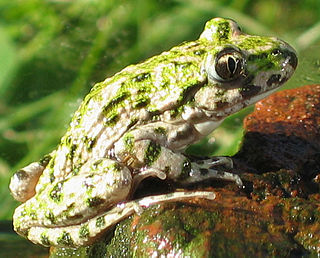
Megophryidae, commonly known as goose frogs, is a large family of frogs native to the warm southeast of Asia, from the Himalayan foothills eastwards, south to Indonesia and the Greater Sunda Islands in Maritime Southeast Asia, and extending to the Philippines. Fossil remains are also known from North America. As of 2014 it encompasses 246 species of frogs divided between five genera. For lack of a better vernacular name, they are commonly called megophryids.

Pelodytidae, also known as the parsley frogs, or rarely, mud divers, is a family of frogs. It contains a single extant genus, Pelodytes, and three genera only known from fossils. The extant species are found in southwestern Europe and the Caucasus.

The Cycloramphidae are a family of frogs endemic to southeastern Brazil. This family has seen large changes in its composition. Genera that have at some point been included in the Cycloramphidae are at present placed in the Alsodidae, Hylodidae, Leptodactylidae, and Rhinodermatidae. Of these, the Alsodidae and/or Hylodidae have also been considered as subfamilies of Cycloramphidae ; the Cycloramphidae, as recognized at present, would be similar to subfamily Cycloramphinae under such system.

Aubria is a small genus of frogs, with two known species. All members of this genus are found in West Africa. Their common name is ball frogs or fishing frogs.

Strongylopus is a genus of pyxicephalid frogs native to Africa. They are found in the area from southwestern South Africa and Namibia to northern Tanzania. Their common name is stream frogs.

Tomopterna is a genus of frogs from sub-Saharan Africa.
Callixalus is a genus frogs in the family Hyperoliidae. It is monotypic, being represented by a single species, Callixalus pictus. It is found in the eastern Democratic Republic of the Congo and western Rwanda. It is sometimes known as the African painted frog.

Paratelmatobius is a genus of frogs in the family Leptodactylidae. They are endemic to southern Brazil.

The Hogsback frog, or Rattray's forest frog, is a species of frog in the family Pyxicephalidae. It is one of three species within the genus Anhydrophryne. It is endemic to the Eastern Cape province of South Africa.

Cacosternum is a genus of frog in the family Pyxicephalidae that are found in southern and eastern Africa. They have many common names, including cacos, dainty frogs, and metal frogs.

Ericabatrachus is a genus of frogs in the family Ericabatrachidae endemic to the Bale Mountains in Ethiopia. It is monotypic, being represented by the single species Ericabatrachus baleensis, commonly known as the Bale Mountains frog. It was previously included in the family Petropedetidae, but has gotten its own monotypic family, Ericabatrachidae.

The micro frog, or Cape Flats frog, is a species of frog less than 2 cm (0.8 in) long in the family Pyxicephalidae, in the monotypic genus Microbatrachella. Its color varies from rufous brown with dark mottling, to tan or green, depending on the population. It is endemic to the south-western Cape area of South Africa, with a single population found on the Cape Flats of Cape Town and several populations on the eastern side of False Bay. It typically lives in wetlands in coastal fynbos habitats, but its total area of occupancy is very small, and the International Union for Conservation of Nature has rated it as being "critically endangered".

Nothophryne broadleyi is a species of frog in the family Pyxicephalidae found on Mount Mulanje (Malawi). It was monotypic within the genus Nothophryne until four new species were described in 2018.

The Petropedetidae are a family of frogs containing two genera and 11 species. They are found in sub-Saharan tropical Africa and are sometimes known under common name African torrent frogs.

The frog family Dicroglossidae occurs in tropical and subtropical regions of Asia and Africa, with most genera and species being found in Asia. The common name of the family is fork-tongued frogs.

Craugastoridae, commonly known as fleshbelly frogs, is a family of New World direct-developing frogs. As delineated here, following the Amphibian Species of the World, it contains 129 species. They are found from the southern United States southwards to Central and South America.

Pyxicephalinae is a subfamily of frogs under the family Pyxicephalidae.

Natal diving frog, also known as the Natal diving frog, Boneberg's frog, or Kloof frog ), is a species of frog in the family Pyxicephalidae. It is the only species within the monotypic genus Natalobatrachus. It is endemic to South Africa. Its natural habitats are temperate forests and rivers and it is threatened by habitat loss.

Ikakogi is a genus of frogs in the family Centrolenidae. It has been tentatively placed in the subfamily Centroleninae, although more recent analyses suggest that it is the sister group of the clade Centroleninae+Hyalinobatrachiinae.


















